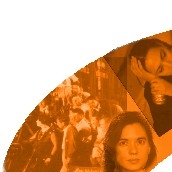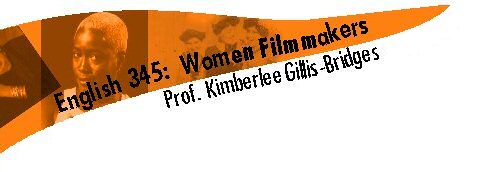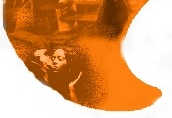


 |
 |
 |
 |
 |
| Course M-TH, 12:00-2:10 More 225 |
| Instructor K. Gillis-Bridges Padelford A305 543-4892 MW, 11:00-11:50 and by appointment |
| Page last updated 7/19/03 |

Cléo – Alone in a Crowded Café
The title character in Agnès Varda’s Cléo from 5 to 7 spends much of the film on a personal journey of discovery; discovery of herself as well as of the world around her. Before she begins this journey, Cléo is an isolated woman, someone who is only able to look within herself and who is unable to make true connections with those around her. Cléo’s existence is defined by being an object of beauty and desire, and at this point in her life she accepts that. This is the state Cléo is in at the beginning of the film, isolated, objectified, and with the specter of death hanging over her. Varda introduces this to the audience in the first café at the Café Ça Va Ça Vient, where through mise-en-scène, shot selection, and camera movement Cléo is shown to be completely objectified and isolated from the world around her.
Varda stages this scene in what can almost be described as a carnival funhouse, or a hall of mirrors. The mirror and reflection motif that is so prominent throughout the film begins to be developed in this setting, and Varda stages the action around these mirrors in order to heighten Cléo’s isolation and objectification. Shortly after entering the café, Cléo looks into the mirror immediately behind her table. However this is no ordinary single mirror, but two mirrors pushed together with an obvious and prominent line down the middle. As she attempts to gaze at her own beauty, the line distorts her reflection and she must move back and forth in order to see her preferred reflection. The mise-en-scène here emphasizes Cléo’s early attempts to objectify herself, to define herself by her beauty, as that is all she has ever known. However through the use of that distorting line, Varda is making it clear that it is no longer so easy for Cléo to objectify herself or be objectified by others. Varda does not allow her main character to have a clear reflection of herself, signifying that she intends Cléo to move away from that and start her journey.
The mise-en-scène is also used to highlight Cléo’s isolation as she sits drinking her coffee while a nearby couple discusses their relationship. Again, Varda makes essential use of a mirror in her staging, this time using it to create in essence two separate frames, one containing the couple and the other isolating Cléo from those around her. Using the reflection from the mirror, Varda is able to completely isolate Cléo in approximately one third of the frame space, giving more room to the neighboring couple. By pushing Cléo to the side of the frame, Varda is painting a picture of a woman alone and disconnected from all the individuals in this crowded café. She shows no immediate interest in what is happening next to her, and Varda never allows her to break that line which separates them. Not only is she isolated, but it appears to be a self-imposed isolation, something Cléo is not yet ready to break out of.
Varda’s shot selection throughout this scene is also very instrumental in demonstrating Cléo’s objectification and isolation. At the beginning of the scene, shortly after Cléo and Angèle have been seated, Cléo proceeds to have some sort of an emotional breakdown. However rather than choosing to shoot Cléo here, Varda instead turns the camera on Angèle and allows her a short interior monologue in which she refers to Cléo as a “drama queen.” Varda’s choice to shoot Angèle here allows the audience to see how even her companions do not take Cléo or her theatrics seriously. She is an object who should be viewed (or not viewed in this case) with condescension.
In a subsequent part of the scene Varda once again chooses shots which do not focus where the conventional wisdom would have them focus; this time that shot selection is able to demonstrate Cléo’s isolation. As Angèle proceeds to tell her story about the man from her village, the audience expects the camera to stay on Angèle. Rather, the shot changes to the one of Cléo and the couple that was described earlier, and with Angèle’s story continuing off-screen. Here Varda has purposefully chosen shots that reflect Cléo’s own interests. Cléo is not interested in Angèle’s story as she is still within her self-imposed isolation. Therefore as Cléo’s mind wanders from the story to become more focused on herself, the camera and the choice of shots follow her state of mind. In these two moments, Varda effectively uses specific shots in order to illustrate the interior thoughts of her characters and how these thoughts contribute to the themes of isolation and objectification.
Finally, Varda does use some minor camera movements in order to heighten the sense of Cléo’s isolation. As Cléo first walks into the café, Varda pans the camera around Cléo as she herself does a slight spin. This camera effect acts to disorientate Cléo as well as the viewer, making it appear that Cléo is the only person in this, as we have already seen, crowded café. Through this very simple camera move at the beginning of the scene, Varda is setting up the theme of isolation that will play throughout the scene and come into prominence as it progresses.
Through
this scene at the Café Ça Va Ça Vient occurs early
in the film, it works to set up the major themes that will play
throughout. Varda introduces these themes of isolation and
objectification through her inventive use of mise-en-scène, shot
selection, and camera movement. Varda’s direction draws the
audience into the film and into the plight of Cléo, ultimately
making us care about this flawed, but evolving character.
Copyright 2003 Jeremy
McColeman
This essay may not be reproduced in any form
without the express consent of the author